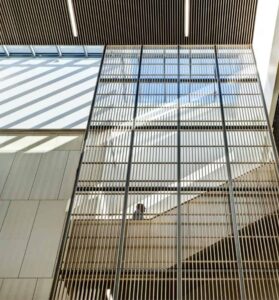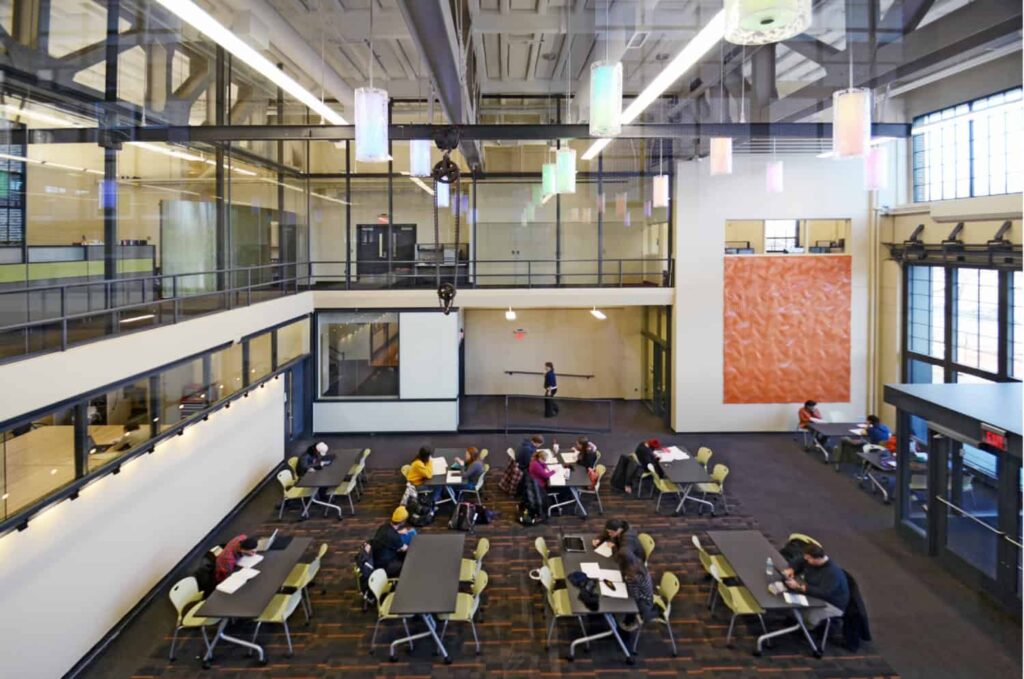Colleges and Universities have emergency preparedness plans and update them frequently. These plans contain policies and procedures to manage threats that might obstruct safety of the campus community. While educational institutions are diligent in their efforts to maintain safety, architects and designers are effective team members who help shape the physical environment to support and improve established safety measures.
Natural Disasters
Architecture can respond and assist in creating solutions for potential threats. While there are complex issues involved, the solutions should be simple in order to minimize vulnerability of a plan. To prepare for a natural disaster, a design team can help determine what investments in infrastructure and communications could improve evacuations and response time. They can also aid in locating and designing tornado shelters, or provide life safety plans in the event of a fire emergency.
Active Shooter
In the case of an active shooter, building entries and exits, corridors and classroom design are the keys to safety. A current debate on campuses is how much glass to use. Often times it is desirable to have ample glass into a classroom so that learning is visible and on display. Of course, ample glass means that there are minimal places for students to hide in an event. The cost of bullet proof glass is high, so other safety options could be considered. Technology can assist in notifying building occupants of the location of the threat, as well as locking areas of a building remotely in the case of an emergency.
Safe rooms may be a possible solution for classrooms, particularly in a remodel situation. There are bullet-proof units that can be purchased, or they can be custom built into the classroom. Safe rooms are not a new concept, but they are a relatively new solution for schools. Whether or not they make financial sense is up to the facility, and their use should be weighed against other safety procedures.
Suicide Attempts

Twelve people aged 15-24 will commit suicide today. According to the American Foundation for Suicide Prevention, firearms are the most common method of suicide, followed by suffocation and poisoning. Suicide from jumping and other methods accounts for 8 percent of all suicide attempts. Colleges work hard to provide awareness and programs to help those with anxiety, depression, and mental health issues. From an architectural standpoint, atriums and balconies pose a threat and should be carefully designed to prevent and discourage falls or suicide attempts.
Terrorist Attacks
When designing a building to resist terrorist attacks, design teams require a comprehensive understanding of potential threats, vulnerabilities and risks. Screening stations at entrances can prohibit small threats from entering a building, while vehicle threats have more extreme criteria. Planning for a vehicle threat requires secure perimeters and screening for underground parking structures. Bollards and landscaping can keep vehicles at a distance from the building to minimize blast impacts. Also, design of the buildings glazing system is extremely important. Because hardening a building’s exterior to resist blast is costly, and greatly affects the appearance, it is more common to address the post-blast behavior of the exterior materials. Laminated glazing is the best option for new construction, while anti-shatter film can be added to existing buildings. The goal is to hold the shards of glass together to protect people from falling debris.
Emergency Response
In-depth discussions are needed between campus safety officials, stakeholders, architects and planners to design with emergency response as a priority. Discussions should focus around questions such as:
- Who are the Campus Safety Officials?
- What are the safety procedures currently in place?
- Where do emergency responders retrieve gear and other necessary items?
- When was campus infrastructure updated? Are all emergency routes satisfactory?
- How are staff trained? How is communication handled?
- Why? Designers should not be afraid to continually ask “why” questions like a 4-year old.
Culture of Safety
While many see the benefits of architecture in the physical space, creating that space in an inclusive and collaborative process with stakeholders across an organization can create ownership that enhances safety. Such a process can help staff and students develop an awareness of how the space operates and flows – from entrances and exits to doorways and internal spaces – that can help make an emergency situation less chaotic. This process also creates the relationships and collegiality that help users of the space recognized suspicious people and activity.
Additionally, a culture of safety can be created through staff training. Even if budgets make hands-on simulations out of reach, table-top simulations allows staff to prepare for potential emergencies through discussions of probable scenarios. It offers participants the ability to use their knowledge of preparedness in a low-stress atmosphere, which invites open discussion and better understanding. Such simulations also reduce uncertainty about an emergency before the emergency happens.
Architects and designers understand the need to balance an open and welcoming learning environment with safety and security. Providing “invisible” safety is key to achieving that balance. Since potential threats cannot be controlled, the goal as designers is to continue to work with campuses to influence outcomes. By understanding the threats and risks; applying safety strategies; and designing for emergency response, the physical environment can be designed to support and improve safety and security procedures in place at colleges and universities.
This is the third of a 3-part series looking at safety and security on college and university campuses. Click to read the first installment, School Violence Dominates Headlines: Can Architects Alter the Story?, and the second installment, Designing for Safety: Using Active, Passive Strategies to Mitigate Risks.








